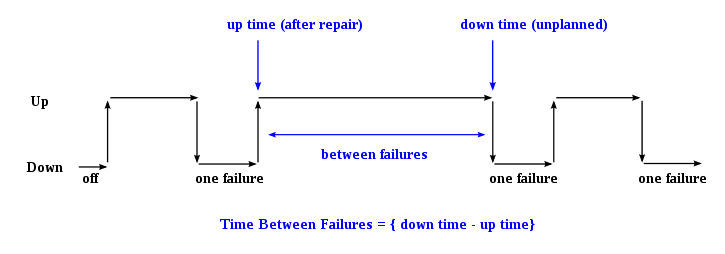MTBF is a crucial metric for maintenance managers to track asset performance and reliability. It provides insights into the reliability of assets by quantifying the average duration between successive failures. By comprehending MTBF and its implications, maintenance managers can strategically plan and execute maintenance activities to enhance asset reliability and minimize downtime, integrating predictive maintenance solutions to further optimize performance.

Defining MTBF and How It Works
MTBF, or Mean Time Between Failure, is the average duration an asset operates without experiencing a failure. This metric is calculated by dividing the total operational time of an asset by the number of failures encountered during that period. Essentially, MTBF represents the reliability of an asset by quantifying the average interval between consecutive failures. Unlike metrics such as Mean Time To Repair (MTTR), which focus on the downtime required for rectifying failures, MTBF zooms in on the operational uptime of assets, providing a comprehensive perspective on their reliability. Condition monitoring can enhance the accuracy of MTBF calculations by continuously assessing the health of assets.
Comparing MTBF to Related Metrics Like MTTR
While MTBF sheds light on the frequency of failures and the ensuing operational uptime, MTTR complements this by gauging the efficiency of maintenance activities in restoring assets to operational status post-failure. MTTR, or Mean Time To Repair, quantifies the average duration required to rectify a failure and resume normal operations. By juxtaposing MTBF and MTTR, maintenance managers can gain a holistic understanding of asset availability. Together, these metrics enable organizations to optimize maintenance strategies, ensuring optimal asset performance and operational efficiency. Incorporating an asset maintenance system can streamline the collection and analysis of these metrics.

Why MTBF Matters for Maintenance Management
The significance of MTBF in maintenance management cannot be overstated. A higher MTBF value signifies greater reliability and prolonged operational uptime of assets, translating into enhanced productivity and reduced downtime. Assets with lower MTBF values necessitate more frequent maintenance interventions to mitigate the risk of failures and uphold operational continuity. By closely monitoring MTBF values, maintenance managers can proactively identify assets exhibiting subpar reliability and prioritize maintenance efforts accordingly. This proactive approach not only minimizes the likelihood of unplanned downtime but also optimizes resource allocation and enhances operational efficiency. Predictive maintenance artificial intelligence can further refine maintenance schedules based on real-time data.
Using MTBF Data to Optimize Maintenance Programs
Leveraging MTBF data empowers maintenance managers to devise targeted maintenance programs tailored to the specific needs of assets. Assets characterized by low MTBF values demand a proactive maintenance approach, wherein preventive maintenance activities are scheduled at regular intervals to preemptively address potential failure triggers. By implementing proactive maintenance strategies, organizations can mitigate the risk of unexpected downtime, prolong asset lifespan, and optimize operational efficiency. Additionally, analyzing MTBF trends over time enables maintenance managers to evaluate the effectiveness of maintenance programs and identify areas for improvement. By identifying patterns and anomalies in MTBF trends, maintenance managers can fine-tune maintenance strategies, optimize resource utilization, and bolster asset reliability. Utilizing online condition monitoring tools can provide continuous insights into asset health, enhancing the reliability of MTBF data.
Limitations of Using MTBF as a Metric
Despite its utility, MTBF possesses inherent limitations that warrant consideration. One such limitation is its assumption of a constant failure rate over the operational lifespan of assets. In reality, the failure rate of assets may vary over time due to factors such as environmental conditions, operational stress, and aging. Consequently, relying solely on MTBF as a predictive metric may lead to inaccuracies and oversights in maintenance planning. Moreover, MTBF fails to account for the cumulative effects of wear and tear on asset reliability over time. As assets age and undergo prolonged usage, their susceptibility to failures may increase, rendering MTBF less indicative of their true reliability. Therefore, while MTBF serves as a valuable tool for assessing asset reliability, it should be complemented by other metrics and qualitative assessments, such as failure mode and effect analysis (FMEA), to ensure comprehensive maintenance planning and decision-making.
Concluding
In conclusion, Mean Time Between Failure (MTBF) offers valuable insights into asset reliability and availability. By quantifying the average duration between failures, MTBF enables maintenance managers to gauge asset reliability, optimize maintenance programs, and minimize downtime. However, it is imperative to acknowledge the limitations of MTBF and supplement it with other metrics and qualitative assessments to ensure robust maintenance planning and decision-making. By harnessing the power of MTBF alongside complementary metrics like MTTR and FMEA, organizations can enhance asset reliability, streamline maintenance operations, and drive operational excellence through maintenance optimization.
Recommended Blog Posts
September 4, 2023
Powerful Signal Analysis Tools for Vibration Analysis
Predictive maintenance, crucial for machinery reliability, heavily relies on vibration analysis. Techniques like FFT…
September 4, 2023
Rotating Machinery Vibration Analysis
Vibration analysis is a critical tool in various industries like manufacturing, power generation, and transportation.…
December 28, 2022
Fault Diagnostic Technique Using Machine Mode Similarity Analysis
AI can diagnose machine faults with vibration data but machine mode similarity analysis is an alternative, it uses…
September 15, 2022
Understanding Rotating Machinery Data
Machine data is generated by physical attributes and actions of machines, collected by sensors and analyzed for…
August 6, 2021
Envelope Analysis
Bearings are critical elements in rotating machines, they support radial and axial loads, and reduce friction. Real…
May 6, 2021
What is Cepstral Analysis?
Cepstral Analysis, a tool used to detect periodicity in frequency spectrum, can be useful in gearbox fault detection in…
October 9, 2020
How is Fault Detection Performed?
Vibration measurements and analysis, using multiple parameters, can identify developing problems in machinery before…
September 21, 2020
Parameter Selections in Vibration Measurement
Vibration measurements are used to determine the response of machines to forces and identify potential issues. It is…
September 4, 2020
What is Vibration Analysis?
Vibration analysis can be used to discover problems in machines and predict when they might fail. It can significantly…
Discover Our Products
Sensemore Predictive Maintenance Solution
If you enjoyed this blog, explore our Predictive Maintenance Solution page.











